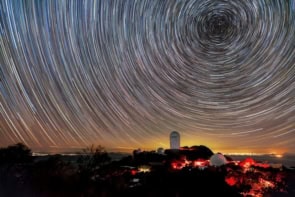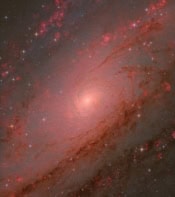In December 2002 astronomers at the University of California in Berkeley got a lucky break. A bright gamma-ray burst appeared in the sky within 18 degrees of the Sun, which was close enough to be picked up by the RHESSI solar satellite. Analysing data from the satellite, Wayne Coburn and Steven Boggs made the stunning discovery that the gamma rays from the burst – named GRB021206 – were linearly polarized. And not just by any amount, but by 80% – the maximum polarization theoretically possible. The discovery represents a major breakthrough in gamma-ray astronomy (Nature 423 415).
Gamma-ray bursts are the most energetic events in the universe, typically corresponding to the conversion of 1% of the mass of the Sun into energy. Every day an average of about one of these brief flashes of gamma rays – which come from any direction in the sky and last a few tens of seconds – are detected. Observations of the optical afterglow of the bursts reveal that they originate in galaxies that are several billions of light-years away. But what causes the bursts, and how the gamma rays are actually produced, have, until recently, remained a mystery.
It has been suggested that gamma-ray bursts result from supernovae – the explosions of massive stars that have used up all their fuel – and that the bursts might be the “birth cries” of black holes. Some of this evidence is circumstantial. It is known, for example, that the host galaxies of the bursts are regions where massive stars are copiously forming. However, observations of the afterglow of GRB980425 in 1998 revealed a spectral signature that would be expected for a supernova. This provided the first compelling, but inconclusive, direct evidence for the link between gamma-ray bursts and supernovae.
In March this year, however, this link was dramatically confirmed. The HETE-2 satellite detected a spectacular gamma-ray burst that was among the closest and brightest ever observed. GRB030329 was just two billion light-years away, which in terms of gamma-ray bursts is right next door.
In the August issue of Physics World Donald Lamb from the University of Chicago explains how optical observations of the burst’s afterglow revealed that it had the characteristic spectrum of a supernova explosion. This spectrum was remarkably similar to GRB984025 just before it reached maximum brightness.



